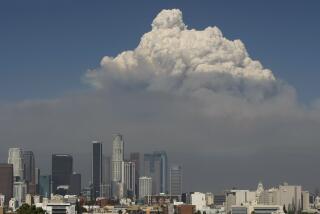He’s Bracing for His Second Event of a Lifetime : Fire Captain Sees Danger Signs for Another Big Blaze
When a runaway firestorm swept through Laguna Canyon in October 1993, Dan Young knew this was the fire he had wanted to fight his entire life.
It was the big one, the fire he had both feared and anticipated since age 16 when he began fighting fires as a summer recruit in El Toro, a job that required a note from his parents.
Young had completed a two-year assignment as public information officer for the county Fire Department the year before the fire broke loose and was enjoying being back on the front lines.
But the Fire Department had other plans for him. They wanted Young to handle the onslaught of media who were rapidly filling oceanfront parking lots in Laguna Beach with news vans and television cameras, broadcasting round-the-clock reports of the devastating fire that turned 441 homes and 14,000 acres to ash.
“I spent 25 years training to fight a fire like that, and then when it happened, my assignment was to try and explain it to people,” Young said. “In many ways, I felt that I missed that fire. I saw film footage of the firefighters I had trained with for 20-some years. I saw them shoulder-to-shoulder in some pretty horrendous firefighting.
“And yet I found myself down at the command post on Pacific Coast Highway, moving from TV camera to TV camera, trying to give information about how to get to the evacuation centers. What I did was probably needed, but at the time I wanted to be in there with the people I had trained with for so many years, doing battle. It’s a personal thing.”
*
The 43-year-old Anaheim resident returned to the ranks earlier this month as captain of the Silverado Canyon Fire Station after nearly five years as public information officer for the department, which became the Orange County Fire Authority last year.
He might have missed the Laguna fire, but Young now finds himself with the same feeling of fear and anticipation. Fire season officially began May 15, and he says the potential for a major wildfire in Orange County has never been higher.
“This is May, but it’s hot and it’s dry like July and August, which raises two questions. Are we going to end up with some tropical storms in the middle of the summer? Or is this the way it’s going to be? If this is the way it’s going to be, this is going to be a very devastating fire season. This stuff is ready to burn,” he said, pointing to the brush-filled Black Star canyon across the street from the rural Fire Station No. 15 where he and two other county firefighters are on call. “Not since the 1980s has it been this warm and this dry in May.
“We had two days of Santa Ana winds in April that have really caused us some concern. The winds took all the moisture out of the plants that would have normally been there another month or two.”
Orange County is more than 10 years behind in conducting controlled burns that could limit the severity of wildfires, Young said.
“We burned about half of the acreage we wanted to burn in the 1980s in Laguna Canyon. It probably wouldn’t have stopped that fire, but it certainly would have given us a fighting chance to control its flanks and control its direction, instead of having it just devastate a community.”
He said there have been no controlled burns in Orange County for the last two years.
“The only time we can burn is about four weeks in the fall and in the spring. Either before it gets too wet or it gets too dry. But during that four-week window, several things have to fall into place: weather, AQMD, environmental concerns and support from the community.
“We can’t have strong winds, but then it can’t be so wet that the brush won’t burn. We can’t put smoke in the air on a smoggy day. We have to determine if there are concerns about environmental issues. And we need community support, but quite often we don’t get it. Communities are very concerned about controlled burns, understandably so. But, unfortunately, we don’t get a lot of time to try and explain the importance of it to them.”
*
The Fire Authority has tried since 1989 to conduct controlled burns in Emerald Bay and the nearby canyons, according to Young.
“Once we couldn’t do it because of weather. Once we couldn’t do it because of environmental concerns. And twice we didn’t have the community support we needed.”
Young, who managed the department’s community education section during his years as public information officer, said the hardest part of the job was convincing Orange County residents that fire is beneficial to the environment.
“We’d better learn to manage these forests and these wild lands year round. These areas burned routinely for thousands of years before we got here, and they were extremely healthy as a result. The Indians used to refer to the Silverado Canyon area as the ‘Valley of the Smokes,’ because there were fires burning on a regular basis.
“We built homes in the area, organized fire departments, put out fires, and all of this winds the spring a little tighter for the big one. Rather than manage these wild lands, from the standpoint of burning them off deliberately when conditions are safe, the community wants us to put all the fires out. But every year that we’re successful in keeping most fires small, the spring is wound a little bit tighter for a devastating fire, which is inevitable.”
More to Read
Sign up for Essential California
The most important California stories and recommendations in your inbox every morning.
You may occasionally receive promotional content from the Los Angeles Times.










